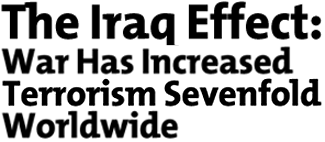|

Has the war
in Iraq increased jihadist terrorism? The Bush administration has offered
two responses: First, the moths-to-aflame argument, which says that Iraq
draws terrorists who would otherwise “be plotting and killing Americans
across the world and within our own borders,” as President Bush put it
in 2005. Second, the hard-to-say position: “Are more terrorists being
created in the world?” then-Secretary of Defense Donald Rumsfeld asked
at a press conference in September 2006. “We don’t know. The world doesn’t
know. There are not good metrics to determine how many people are being
trained in a radical madrasa school in some country.”
In fact,
as Rumsfeld knew well, there are plenty of publicly available figures
on the incidence and gravity of jihadist attacks. But until now, no one
has done a serious statistical analysis of whether an “Iraq effect” does
exist. We have undertaken such a study, drawing on data in the mipt-rand
Terrorism database (terrorismknowledgebase .org), widely considered the
best unclassified database on terrorism incidents.
Our study
yields one resounding finding: The rate of fatal terrorist attacks around
the world by jihadist groups, and the number of people killed in those
attacks, increased dramatically after the invasion of Iraq. Globally there
was a 607 percent rise in the average yearly incidence of attacks (28.3
attacks per year before and 199.8 after) and a 237 percent rise in the
fatality rate (from 501 to 1,689 deaths per year). A large part of this
rise occurred in Iraq, the scene of almost half the global total of jihadist
terrorist attacks. But even excluding Iraq and Afghanistan—the other current
jihadist hot spot—there has been a 35 percent rise in the number of attacks,
with a 12 percent rise in fatalities.
Contrary
to Bush’s assertion, jihadists have not let the Iraq War distract them
from targeting the United States and its allies. The rate of attacks on
Western interests and citizens has risen by almost 25 percent, while the
yearly fatality rate has increased by 4 percent, a figure that would have
been higher had planned attacks, such as the London airline plot, not
been prevented.
The globalization
of jihad and martyrdom has disquieting implications for American security
in the future. Jihadists are already leaving Iraq to operate elsewhere,
a “blowback” trend that will greatly increase when the war eventually
winds down. Terrorist groups in Iraq, which have learned to raise millions
through kidnapping and oil theft, may be in a position to help fund their
jihadist brethren elsewhere. Finally, Iraq has increased the popularity
of a hardcore takfiri ideology so intolerant that, unlikely as it seems,
it makes Osama bin Laden appear relatively moderate.
Though few
American civilians have been killed by jihadist terrorists in the past
three years, it is naive to assume that this will continue to be the case.
We will be living with the consequences of the Iraq debacle for many years.
|
Mother
Jones’ “Iraq Effect” study was led by Peter Bergen and Paul
Cruickshank, research fellows at the Center on Law and Security
at the New York University School of Law.
Read
the complete report here.
|
|
Iraq’s
Newest Export: Refugees
1.6 million
Iraqis have been displaced within the country. As many as 1.8 million
have left Iraq, with 3,000 fleeing daily. Saudi Arabia is building a 560-mile
border fence to keep them out. As many as 700,000 Iraqi refugees now live
in Jordan. More than 60,000 live in Sweden. Only 202 were admitted to
the United States last year.
Iraq:
Before and After
In 2006,
30% of Iraqi children went to school. Before the war, attendance was nearly
100%. A 2006 survey of children in Baghdad found that 47% had recently
experienced a major traumatic event; 14% had posttraumatic stress disorder.
An American psychiatrist says Iraqis are suffering “epidemic levels of
ptsd.” 40% of Iraqi professionals have fled, including 1/3 of all doctors.
2,000 doctors have been murdered since 2003. The number of Iraqis in jail
or prison is up 30% since the fall of Saddam Hussein. The president of
the Iraqi National Council of Women does not go out without bodyguards.
“I started with 6, then I increased to 12, and then to 20 and then 30.”
One of the 66 women in the Iraqi Parliament told the UK Observer, “This
is the worst time ever in Iraqi women’s lives. In the name of religion
and sectarian conflict they are being kidnapped and killed and raped.”
|





